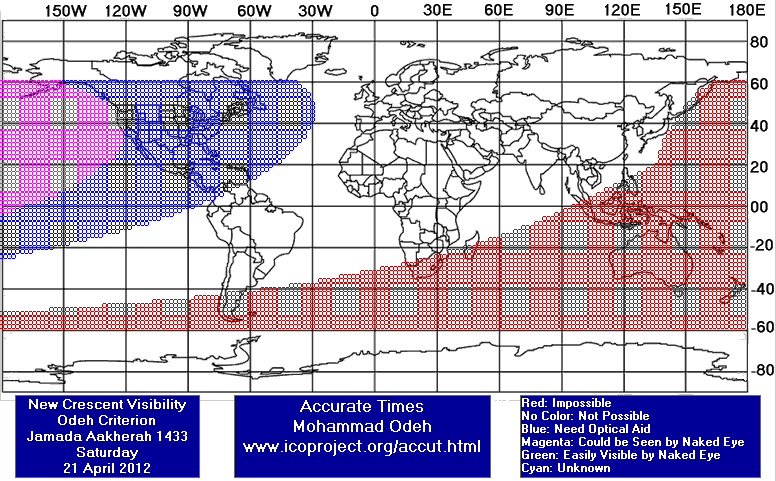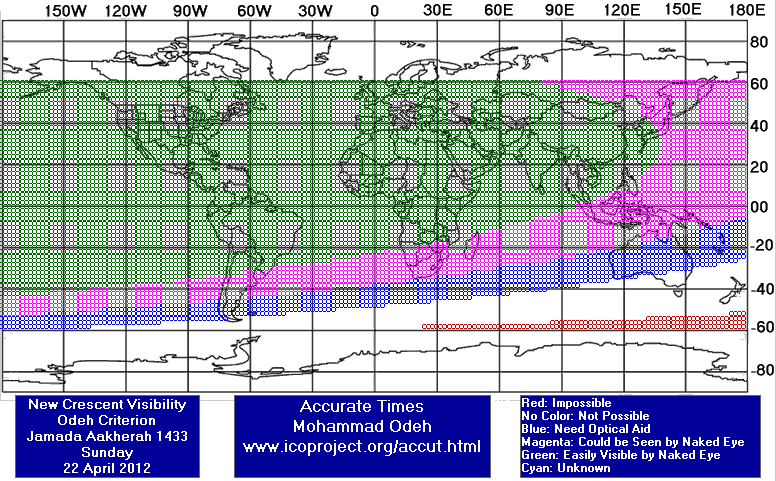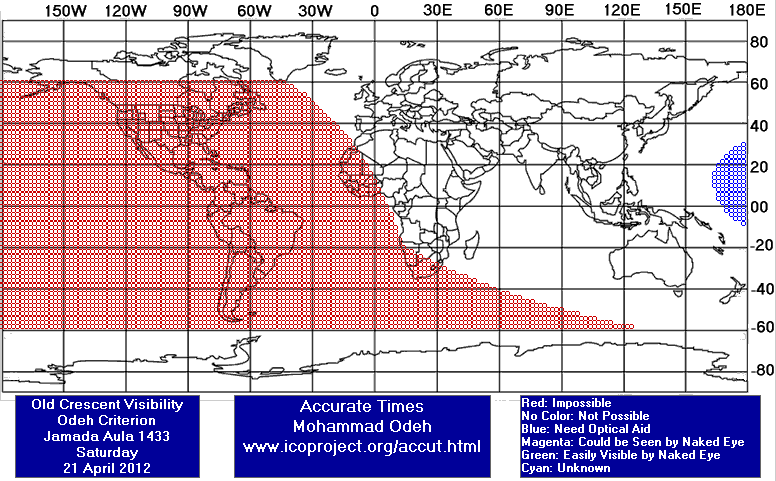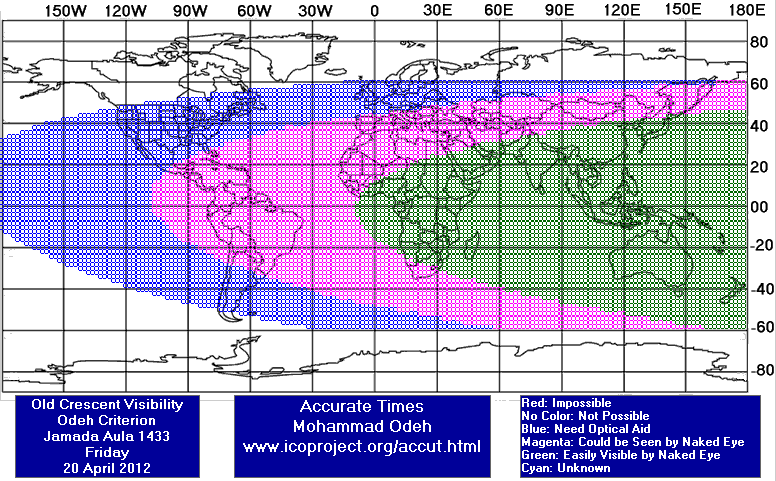Visibility of Jumadal Al-Aakherah Crescent 1433 AH
- When to Observe Jumadal Al-Aakherah Waxing (NEW) Crescent ?
- Jumadal Al-Aakherah Waxing (NEW) Crescent Observation Results
- The OFFICIAL First Day in Different Countries
- When to Observe Jumadal Al-Aula Waning (OLD) Crescent ?
- Jumadal Al-Aula Waning (OLD) Crescent Observation Results
When to Observe Jumadal Al-Aakherah Waxing (NEW) Crescent ?
The geocentric conjunction (Geocentric New Moon) will occur Inshalla on (Saturday 21 April 2012) at 07:18 UT.
Sighting the new crescent on (Saturday 21 April 2012) and (Sunday 22 April 2012) is shown in the below graphs using the program Accurate Times by Mohammad Odeh according to Odeh criterion. Where:-
- It is impossible to see the crescent from the areas located under the red color. Because either the Moon on this day sets before the Sunset and/or the topocentric conjunction occurs after the Sunset.
- The crescent is expected to be seen by optical aid only from the areas located under the blue color.
- The crescent is expected to be seen by optical aid from the areas located under the magenta color. In these areas the crescent could be seen by naked eye if the atmospheric conditions are superb and the observer is experienced.
- The crescent is expected to be easily visible by naked eye from the areas located under the green color.
- The crescent cannot be seen from uncolored areas, even though the Moon sets in these locations after the Sunset and the topocentric conjunction occurs before the Sunset, but the Moon is not sufficiently illuminated in order to be seen as crescent even by optical aid.
- Kindly notice that the below graph shows the possibility of seeing the crescent from areas between 60 degrees north of Equator down to 60 degrees south of Equator.


According to the Universal Hejric Calendar (UHC), which is based on the calculated crescent visibility, the start of this month in the Eastern Region will be on Monday 23 April 2012 and in the Western Region will be on Sunday 22 April 2012. Kindly notice that the UHC is a pre-calculated calendar, which adopts a certain criterion to start the new Hejric month. Your country/organization might adopt different criterion to start the new Hejric month. So it is highly advised to read the UHC website before giving any judgment.
- Results of seeing the crescent, and the first day of the month in different countries will be added here Inshalla as we receive the reports from ICOP's members. If you wish to be a member in ICOP, or to know more about it, kindly click here.
Jumadal Al-Aakherah Waxing (NEW) Crescent Observation Results
Sat 21 April 2012
Germany
Eng. Martin Elsaesser said: "The young crescent of 21. April was very difficult, as conjunction was very close at only 2.2° elongation. We had good clear skies before noon, but did not attempt to see the crescent due to the extreme closeness to the sun. Around noon, the skies started to get more cloudy, with layers of high altitude haze, so we did not expect any chance to observe in the evening. The clarity of the air was excellent though, due to the wind and dry air. Unexpectedly, around 17:00 a huge gap in the clouds started to form from a local weather phenomenon called the "Föhn", so i hurriedly set up a crescent imaging telescope at the public astronomical observatory in the center of munich, not having the time to go to a better location. I also asked two visitors from Oman to join me, as we had been testing the crescent telescope for a few days. After setup of the instrument on a neighboring roof we aligned the goto-system on the sun, adjusted focus by looking at jupiter and then sent the goto system to the position of the moon. We moved the instrument slighly downwards, to get the actual crescent into the center of the field of view. We used the prototype of a spezialized software to automatically adjust camera settings and do the real time image processing, so we mainly stood around without much to do, staring on the screen to look for the crescent. We could not clearly see the crescent on the screen, but a quick review of the automatically saved images showed a thin arc of light moving among the haze and noise, so we rejoiced. Alas, it quickly became clear that the gap in the clouds was only temporary and that we would not be able to observe until sunset. We first found the crescent around 19:05 (UT+2), at an elongation of 4.23°, an altitude of 14°, about 75 minutes before sunset. We lost it to the fast-moving clouds around 15 minutes later, about one hour before sunset. When inspecting the captured images later, i found no single good, convincing image. So i cut about 60 images from the stream and combined them to a short video, which clearly shows the moving arc. The short video can be found on my homepage: http://www.mondatlas.de/other/martinel/sicheln2012/april/index.html So, a nice, if short observation of the crescent at very small elongations. Sadly, the clouds prevented us from following the crescent till after sunset and we also could not try visual observation, though the telescope would have been ready for it. The special software worked fine, but needs a few more tweaks."
Lebanon
Saudi Arabia
United Kingdom
Eng. Qamar Uddin said: "On Saturday, 21 April 2012 (29 Jumada al-Ula 1433 AH) many people from throughout UK have attempted to sight the crescent moon (Hilal) of Jumada Al-Ukhra after sunset. None of the groups were able to sight the Hilal, as most places were cloudy/rainy. We have not received any reliable sighting reports (Muhaqaq-Ruyat-Basari) from any countries east of UK/Morocco either. But, we have received a negative sighting report from Morocco Awqaf Ministry. Therefore, the Wifaq/Batley Ulama have decided that the month of Jumada al-Ula 1433 AH will completed 30 days and the month of Jumada Al-Ukhra 1433 AH will start from Monday 23 April 2012 (i.e. sunset of 22 April 2012), Insha-Allah."
United States
Mr. Jim Stamm said: "New Moon Crescent Observation Report ====================================== Observed: Saturday; April 21, 2012 - 19:14 (Local) Location (WGS 84) = Tucson, Arizona (USA) Longitude = 110.9651 W Latitude = 32.4206 N Elevation = 842 meters Time Zone = -7.0 hours Surface conditions at location: Temperature = 30 °C Humidity = 10 % Pressure = 29.73 in. Only very slight haze kept the sky from being perfect. Magnitude limit at 4 degrees altitude with 80 power in C-8 telescope, after onset of twilight was 9.5, and this wavered to much less at times. It appears that this magnitude measurement is not a good indication of the sky’s transparency for evening, new moon crescent observations. Topocentric and local time values from “Accurate Times”: Sunset (at sea level) = 19:03 Moonset (at sea level) = 19:44 Time from new moon at 19:14 = 18 hr. 34 min. Moon lag time = 41 min. Relative Altitude = 7.9 degrees Elongation from sun = 7.9 degrees Crescent width = 9 arc seconds Illumination = 0.5 percent Crescent first observed through 8” SC telescope: Time = 19:14 Moon Altitude = 3.9 degrees Final observation with telescope: Time = 19:27 Moon Altitude = 1.4 degrees The crescent was easily seen entering the eyepiece field at 19:14. It extended from about 20 arc degrees to about 50 degrees in several seconds, then to 70 degrees in a minute. It dropped back to about 60 degrees, and stayed like that for about 8 or 9 minutes. Then it quickly lessened to about 30 degrees, until I lost it in the trees at 19:27. There were several degrees of the arc that stayed invisible, leaving about twice as much arc separated from the rest of the crescent. None of my photographs (zoomed, but not using the telescope optics) picked up the crescent. Observers: Jim and Chris Stamm E-mail Address: StammJim@gmail.com"
Sun 22 April 2012
Algeria
Mr. Hocine Chikh Aissa said: "(25) persons were present in n'tissa station and have tried to observe the Jumada II 1433 crescent. the crescent was seen. They have used three binoculars : 60x20, 50x07 and 50x08 and telescop."
Germany
Eng. Martin Elsaesser said: "The day started rainy, but got better in the afternoon. Between the clouds, the air was very clear. The crescent could first be seen around 18:40 (UT+2), some 90 minutes before sunset, using a small telescope at 50x. The sky was good blue and the crescent appeared as a whiter arc, even showing some structure. Jupiter could also be seen and even showed cloudbelts at that time. After sunset, the crescent could easily be seen with the naked eye, with jupiter 2 degrees to the left."
Iran
Mr. Alireza Mehrani said: "Latitude: 32° 35' 27.69" N Longitude: 51° 38' 10.88" E Elevation: 2081 meters from sea level Time zone: +4.5 Observer & photographer: Alireza Mehrani Date: Sunday April 22, 2012 (Ordibehesht 3, 1391) Topocentric and local time values from "Moon Calculator" (Refrac off): Crescent first observation through 7x50 binoculars: Time: 19:50 LT (15:20 UT) Moon Alt: 10° 21' 19" Sun Alt: - (3° 09' 49") Elongation: 13° 40' 08" Rel Azi: - (2° 01' 40") Moon Width: 0.42' Moon Phase: 1.61% Moon Age: 32h 02m after conjunction Crescent first observation through naked eyes: Time: 20:05 LT (15:35 UT) Crescent last observation through 7x50 binoculars: Time: 20:14 LT (15:44 UT) "
Malaysia
Mr. Kassim Bahali said: "The hilal was seen at Al-Khawarizmi Observatory with Meade LX200 8" and naked eyes."
Mr. Firdaus Mazlan said: "On Sunday, 22th April 2012 M equal to 29th Jumada-al-Oola 1433 H, I with my friend (Mr. Mohammad Haniff bin Md Yusoff, Mr. Muhammad Zainal Abiden bin Mohamad Hani, Mr. Asmanizam bin Ghani, Mr. Mohd Fahmi bin Zakaria, Mr. Abdul Hai Amri bin Alias, Mr. Mohd Fairuz, Mr. Nadzrin) have seen the new moon with naked eye at Baitul Hilal, Teluk Kemang, Negeri Sembilan, Malaysia (02:26:43.0 N , 101:51:16.0 E). The crescent was first seen by Telescope at 7.38 pm. After that, we can see the crescent at 7.46 pm until 7.55 pm. So, tomorrow, 23th April 2012 M (Monday) is 1st Jumada-al-Thani 1433 H. The goverment also announced that tomorrow is 1st Jumada-al-Thani 1433 H. "
Nigeria
Mr. Qamarudeen Muhammad said: "I couldn't sight the new hilal tonight"
Pakistan
Mr. Alam Sultan said: "Alhamdolillah, today (Sunday 22 April 2012= 29 Jumadal-oola 1433 in Pakistan), On my request, a large number of people (members of the moon-sighting committees of our institute "JAMIA-TUR-RASHEED" + my friends + their companions) easily sighted the moon at 16 places in all 4 provinces. Due to haze, some clouds and low phase of moon(less than 2%) I could not sight it myself in Karachi. Note 1: Chairman of central official moon sighting committee of Pakistan mufti munee-bur-Rahman told me on my mobile phone that as he also received positive reports therefore he announced officially that Monday 23 April 2012 is 1st Juma-dath-Thaniah 1433 in Pakistan. Jumadal-oola month finished on 29th day. Note2 : After some days, inshaallah, a detailed report of this observation in Urdu will be available. "
Saudi Arabia
Mr. Saleh Al-Saab said: "The atmosphere was very dusty, the sun disappeared 30 minutes before sunset."
South Africa
Dr. Abdurrazak Ebrahim said: "The Hilaal was not seen in Cape Town but it was seen by naked-eye in the northern South African areas of Rustenburg and Johannesburg."
Tanzania
Mr. Zaffar Sheriff said: "The crescent was easily sighted."
United States
Dr. Javad Torabinejad said: "My son and I arrived at our sighting location at 7:58 pm EDT (sunset: 8:03 pm). The sky was cloudy. We stayed there till 8:13 pm (moonset: 9:36 pm)."
The OFFICIAL First Day in Different Countries
Sun 22 April 2012
1 . Nigeria
2 . Saudi Arabia
Mon 23 April 2012
1 . Iran
2 . Malaysia
3 . Pakistan
4 . South Africa
5 . United Kingdom
When to Observe Jumadal Al-Aula Waning (OLD) Crescent ?
The geocentric conjunction (Geocentric New Moon) will occur Inshalla on (Saturday 21 April 2012) at 07:18 UT.
Sighting the OLD crescent on (Saturday 21 April 2012) and on (Friday 20 April 2012) is shown in the below graphs using the program Accurate Times by Mohammad Odeh according to Odeh criterion. Where:-
- It is impossible to see the OLD crescent from the areas located under the red color. Because either the Moon on this day rises after the Sunrise and/or the topocentric conjunction occurs before the Sunrise.
- The crescent is expected to be seen by optical aid only from the areas located under the blue color.
- The crescent is expected to be seen by optical aid from the areas located under the magenta color.. In these areas the crescent could be seen by naked eye if the atmospheric conditions are superb and the observer is experienced.
- The crescent is expected to be easily visible by naked eye from the areas located under the green color.
- The crescent cannot be seen from uncolored areas, even though the Moon rises in these locations before the Sunrise and the topocentric conjunction occurs after the Sunrise, but the Moon is not sufficiently illuminated in order to be seen as crescent even by optical aid.
- Kindly notice that the below graph shows the possibility of seeing the crescent from areas between 60 degrees north of Equator down to 60 degrees south of Equator.


Jumadal Al-Aula Waning (OLD) Crescent Observation Results
Fri 20 April 2012
Iran
Mr. Alireza Mehrani said: "Location: Esfahan, Iran Latitude: 32° 35' 40.01" N Longitude: 51° 39' 28.35" E Elevation: 1772 meters from sea level Time zone: +4.5 Observer & photographer: Alireza Mehrani Date: Friday April 20, 2012 (Ordibehesht 1, 1391) Topocentric and local time values from "Moon Calculator" (Refrac off): File: amehrani April 20, 2012 old.jpg Time: 05:57 LT (01:27 UT) Moon Alt: 2° 54' 03" Sun Alt: - (7° 06' 24") Elongation: 13° 27' 04" Rel Azi: 9° 00' 20" Moon Width: 0.41' Moon Phase: 1.52% Moon Age: 29h 51m before conjunction "
United States
Mr. Jim Stamm said: "Old Moon Crescent Observation Report ====================================== Observed: Friday; April 20, 2012 - 05:53 (Local) Location (WGS 84) = Tucson, Arizona (USA) Longitude = 110.9651 W Latitude = 32.4206 N Elevation = 842 meters Time Zone = -7.0 hours Surface conditions at location: Temperature = 15 °C Humidity = 31 % Pressure = 29.85 in. Only slight haze and nearby thin banded cirrus kept the sky from being perfect. Magnitude limit at 7 degrees altitude with 80 power in C-8 telescope, before onset of twilight = 11.0 Topocentric and local time values from “Accurate Times”: Moonrise (at sea level) = 05:09 Sunrise (at sea level) = 05:43 Time from new moon at 05:53 = 18 hr. 47 min. Moon lag time = 34 min. Relative Altitude = 6.9 degrees Elongation from sun = 8.5 degrees Crescent width = 10 arc seconds Illumination = 0.5 percent I was NOT able to see the crescent, even through a telescope. The sky seemed to be more clear than last month, and I speculate that either 31% humidity is too much, or the crescent’s altitude lessened its contrast, thus making it invisible. Location and focus were precise. Observer(s): Jim Stamm E-mail Address: StammJim@gmail.com"





